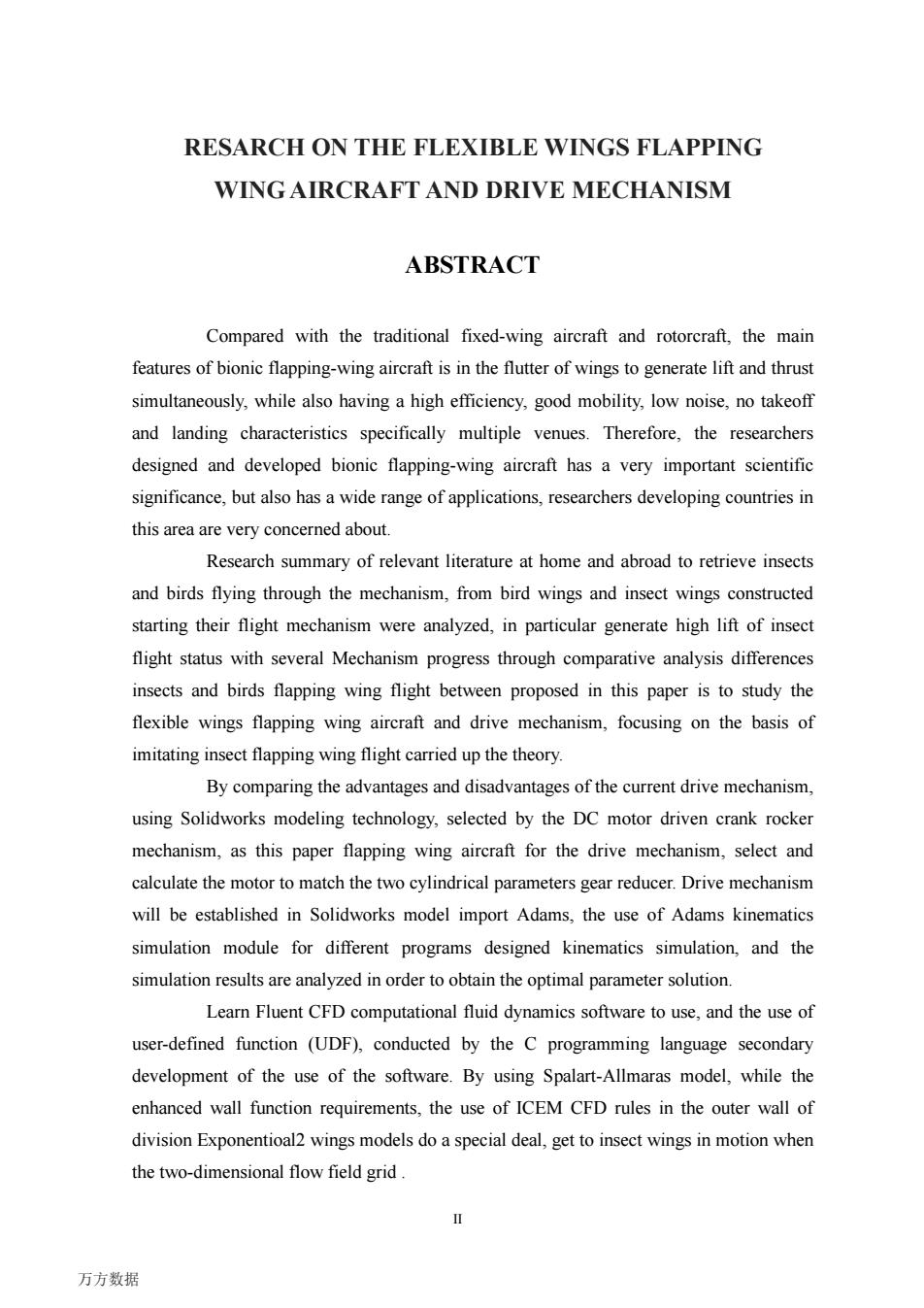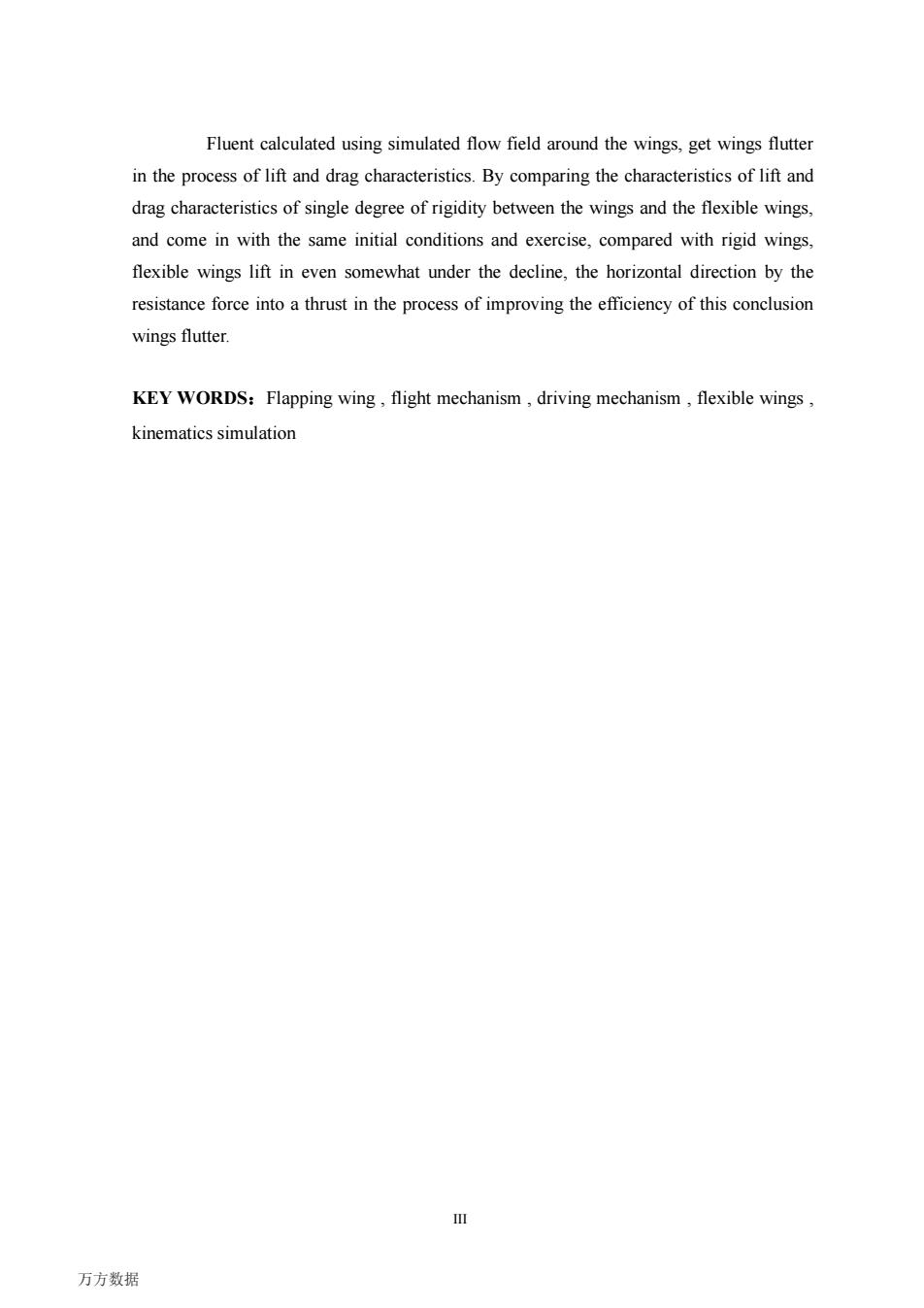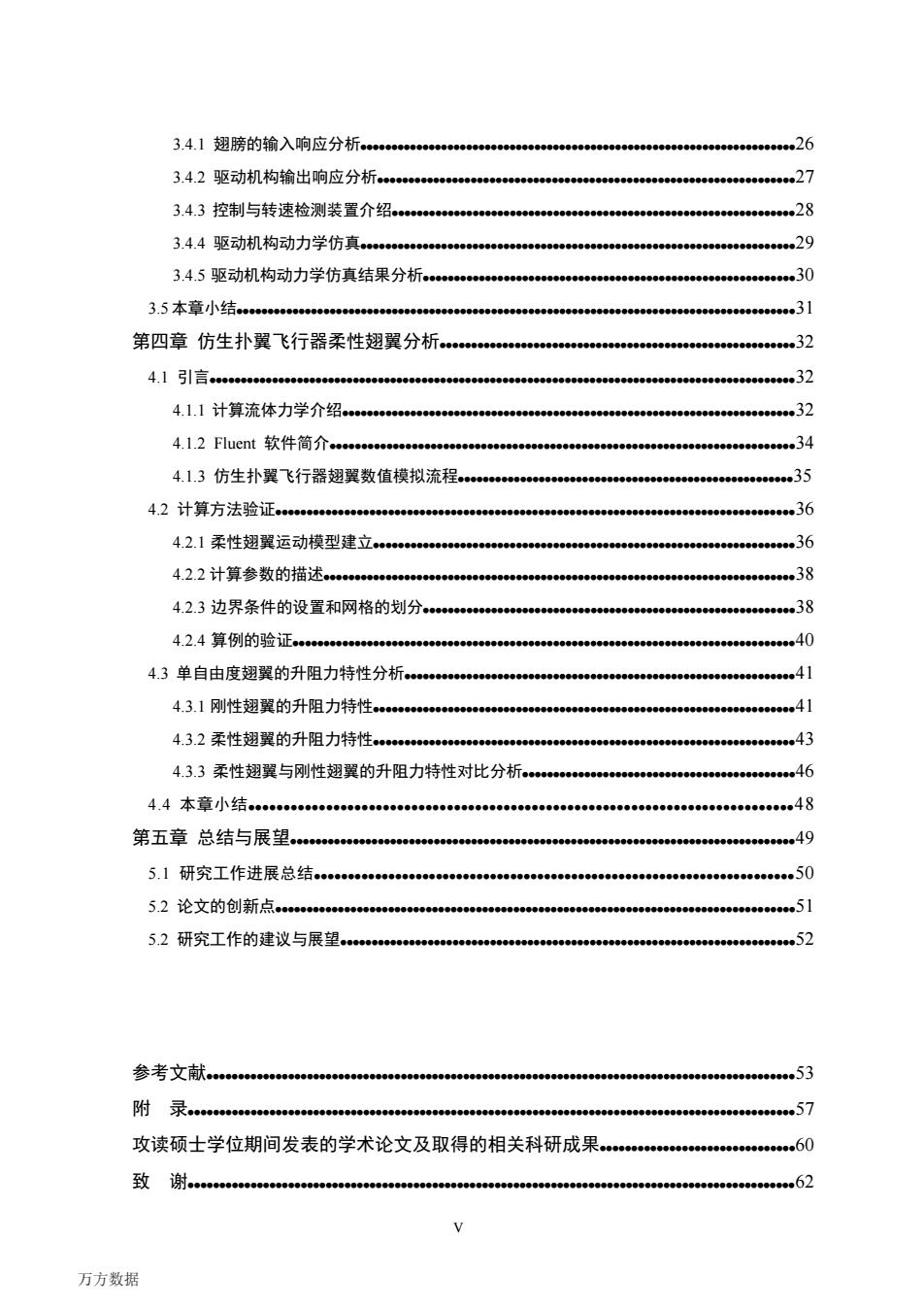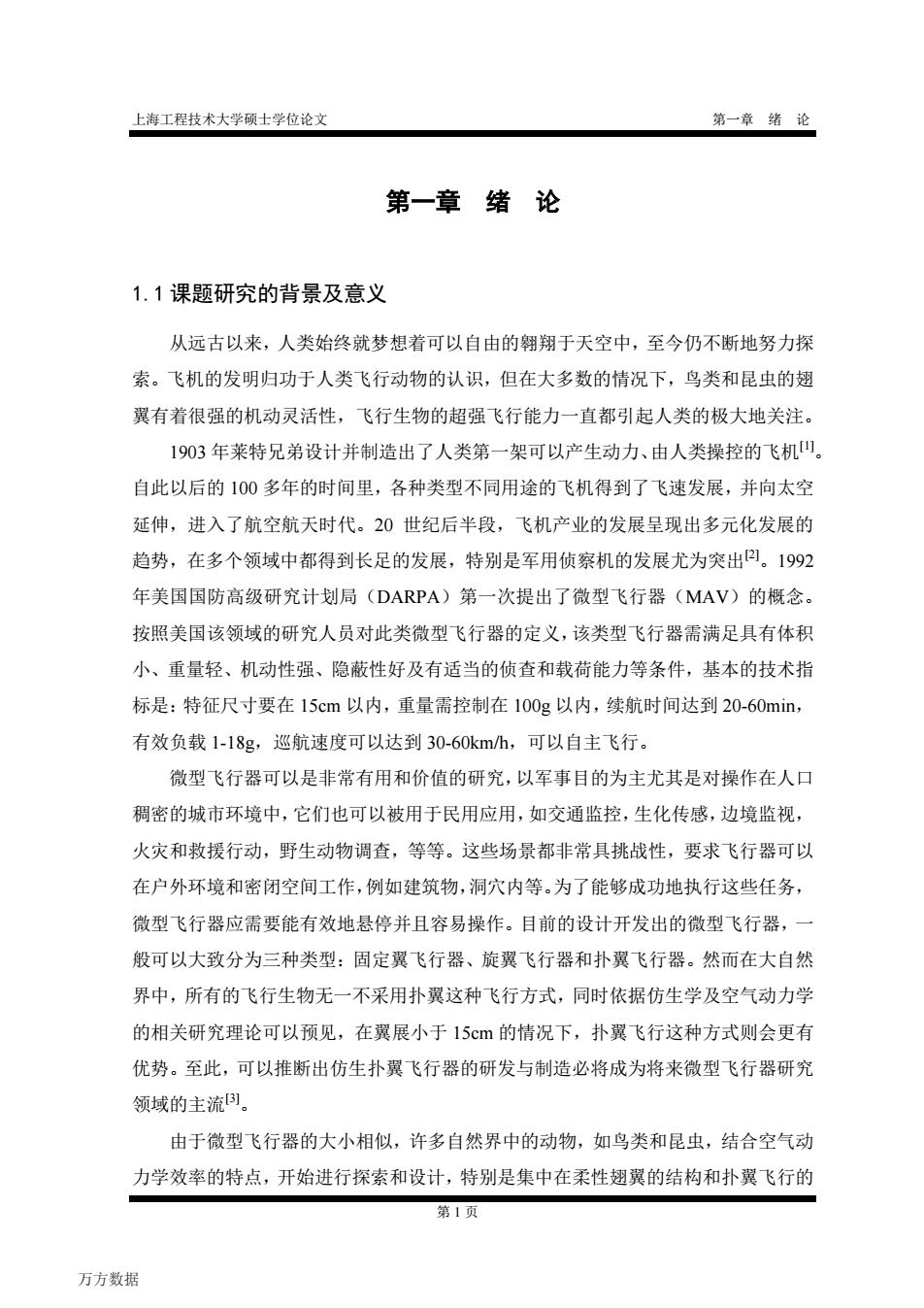
RESARCH ON THE FLEXIBLE WINGS FLAPPING WING AIRCRAFT AND DRIVE MECHANISM ABSTRACT Compared with the traditional fixed-wing aircraft and rotorcraft,the main features of bionic flapping-wing aircraft is in the flutter of wings to generate lift and thrust simultaneously,while also having a high efficiency,good mobility,low noise,no takeoff and landing characteristics specifically multiple venues.Therefore,the researchers designed and developed bionic flapping-wing aircraft has a very important scientific significance,but also has a wide range of applications,researchers developing countries in this area are very concerned about. Research summary of relevant literature at home and abroad to retrieve insects and birds flying through the mechanism,from bird wings and insect wings constructed starting their flight mechanism were analyzed,in particular generate high lift of insect flight status with several Mechanism progress through comparative analysis differences insects and birds flapping wing flight between proposed in this paper is to study the flexible wings flapping wing aircraft and drive mechanism,focusing on the basis of imitating insect flapping wing flight carried up the theory. By comparing the advantages and disadvantages of the current drive mechanism, using Solidworks modeling technology,selected by the DC motor driven crank rocker mechanism,as this paper flapping wing aircraft for the drive mechanism,select and calculate the motor to match the two cylindrical parameters gear reducer.Drive mechanism will be established in Solidworks model import Adams,the use of Adams kinematics simulation module for different programs designed kinematics simulation,and the simulation results are analyzed in order to obtain the optimal parameter solution. Learn Fluent CFD computational fluid dynamics software to use,and the use of user-defined function (UDF),conducted by the C programming language secondary development of the use of the software.By using Spalart-Allmaras model,while the enhanced wall function requirements,the use of ICEM CFD rules in the outer wall of division Exponentioal2 wings models do a special deal,get to insect wings in motion when the two-dimensional flow field grid I 万方数据
II RESARCH ON THE FLEXIBLE WINGS FLAPPING WING AIRCRAFT AND DRIVE MECHANISM ABSTRACT Compared with the traditional fixed-wing aircraft and rotorcraft, the main features of bionic flapping-wing aircraft is in the flutter of wings to generate lift and thrust simultaneously, while also having a high efficiency, good mobility, low noise, no takeoff and landing characteristics specifically multiple venues. Therefore, the researchers designed and developed bionic flapping-wing aircraft has a very important scientific significance, but also has a wide range of applications, researchers developing countries in this area are very concerned about. Research summary of relevant literature at home and abroad to retrieve insects and birds flying through the mechanism, from bird wings and insect wings constructed starting their flight mechanism were analyzed, in particular generate high lift of insect flight status with several Mechanism progress through comparative analysis differences insects and birds flapping wing flight between proposed in this paper is to study the flexible wings flapping wing aircraft and drive mechanism, focusing on the basis of imitating insect flapping wing flight carried up the theory. By comparing the advantages and disadvantages of the current drive mechanism, using Solidworks modeling technology, selected by the DC motor driven crank rocker mechanism, as this paper flapping wing aircraft for the drive mechanism, select and calculate the motor to match the two cylindrical parameters gear reducer. Drive mechanism will be established in Solidworks model import Adams, the use of Adams kinematics simulation module for different programs designed kinematics simulation, and the simulation results are analyzed in order to obtain the optimal parameter solution. Learn Fluent CFD computational fluid dynamics software to use, and the use of user-defined function (UDF), conducted by the C programming language secondary development of the use of the software. By using Spalart-Allmaras model, while the enhanced wall function requirements, the use of ICEM CFD rules in the outer wall of division Exponentioal2 wings models do a special deal, get to insect wings in motion when the two-dimensional flow field grid . 万方数据

Fluent calculated using simulated flow field around the wings,get wings flutter in the process of lift and drag characteristics.By comparing the characteristics of lift and drag characteristics of single degree of rigidity between the wings and the flexible wings, and come in with the same initial conditions and exercise,compared with rigid wings, flexible wings lift in even somewhat under the decline,the horizontal direction by the resistance force into a thrust in the process of improving the efficiency of this conclusion wings flutter. KEY WORDS:Flapping wing,flight mechanism,driving mechanism,flexible wings, kinematics simulation Ⅲ 万方数据
III Fluent calculated using simulated flow field around the wings, get wings flutter in the process of lift and drag characteristics. By comparing the characteristics of lift and drag characteristics of single degree of rigidity between the wings and the flexible wings, and come in with the same initial conditions and exercise, compared with rigid wings, flexible wings lift in even somewhat under the decline, the horizontal direction by the resistance force into a thrust in the process of improving the efficiency of this conclusion wings flutter. KEY WORDS:Flapping wing , flight mechanism , driving mechanism , flexible wings , kinematics simulation 万方数据

目录 第一章绪 1.1课题研究的背景及意义。 1.1.1固定翼飞行器 1.1.2旋翼飞行器 1.1.3扑翼飞行器。w0 1.2仿生扑翼飞行器柔性翅翼及驱动机构研究进展… 1.2.1国外扑翼飞行器柔性翅翼及驱动机构研究现状 1.2.2国内扑翼飞行器柔性翅翼及驱动机构研究现状。6 1.2.3国内外扑翼飞行器柔性翅翼及驱动机构研究现状分析.9 1.3本文研究的主要内容。0w 第二章鸟类与昆虫扑翼飞行机理分析 2.1☑引言.0000000000000000000000000000o00000000000000000 2.2昆虫扑翼飞行机理分析。w 2.2.1拍合飞行(Clap-Fling)w 2.2.2旋转环流(Rotational Circulation)., 2.2.3尾流捕获(Wake Capture) 2.2.4延迟失速(Delayed Stall)) 2.2.5翼尖涡流(Tip Vortex)r ooso014 2.2.6翻转机制(Passive Pitching Mechanism) 2.3鸟类扑翼飞行机理分析。 2.4鸟类和昆虫扑翼飞行方式的差异分析… 2.5本章小结000000000000000 第三章仿生扑翼飞行器驱动机构的设计与分析… 3.1扑翼飞行方式对驱动机构的要求 oessooee 18 3.2仿生扑翼飞行驱动方式的分析与选择。… eeeeeee18 3.3仿生扑翼飞行器驱动机构的设计 eeeeoeooooeoo000020 3.3.1减速器的设计 0e000000000e0,21 3.3.2扑翼驱动机构的建模与设计, 000000,22 3.4扑翼飞行器驱动机构的动力学分析。… .26 Iv 万方数据
IV 目 录 第一章 绪 论●●●●●●●●●●●●●●●●●●●●●●●●●●●●●●●●●●●●●●●●●●●●●●●●●●●●●●●●●●●●●●●●●●●●●●●●●●●●●●●●●●●●●●●●1 1.1 课题研究的背景及意义●●●●●●●●●●●●●●●●●●●●●●●●●●●●●●●●●●●●●●●●●●●●●●●●●●●●●●●●●●●●●●●●●●●●●●●●●●1 1.1.1 固定翼飞行器●●●●●●●●●●●●●●●●●●●●●●●●●●●●●●●●●●●●●●●●●●●●●●●●●●●●●●●●●●●●●●●●●●●●●●●●●●●●●●●●2 1.1.2旋翼飞行器●●●●●●●●●●●●●●●●●●●●●●●●●●●●●●●●●●●●●●●●●●●●●●●●●●●●●●●●●●●●●●●●●●●●●●●●●●●●●●●●●●●2 1.1.3扑翼飞行器●●●●●●●●●●●●●●●●●●●●●●●●●●●●●●●●●●●●●●●●●●●●●●●●●●●●●●●●●●●●●●●●●●●●●●●●●●●●●●●●●●●3 1.2 仿生扑翼飞行器柔性翅翼及驱动机构研究进展●●●●●●●●●●●●●●●●●●●●●●●●●●●●●●●●●●●●●●●●●●●●●●●●4 1.2.1 国外扑翼飞行器柔性翅翼及驱动机构研究现状●●●●●●●●●●●●●●●●●●●●●●●●●●●●●●●●●●●●●●●●●●●4 1.2.2 国内扑翼飞行器柔性翅翼及驱动机构研究现状●●●●●●●●●●●●●●●●●●●●●●●●●●●●●●●●●●●●●●●●●●●6 1.2.3 国内外扑翼飞行器柔性翅翼及驱动机构研究现状分析●●●●●●●●●●●●●●●●●●●●●●●●●●●●●●●●●●●9 1.3 本文研究的主要内容●●●●●●●●●●●●●●●●●●●●●●●●●●●●●●●●●●●●●●●●●●●●●●●●●●●●●●●●●●●●●●●●●●●●●●●●●●●●●●9 第二章 鸟类与昆虫扑翼飞行机理分析●●●●●●●●●●●●●●●●●●●●●●●●●●●●●●●●●●●●●●●●●●●●●●●●●●●●●●●●●11 2.1 引言●●●●●●●●●●●●●●●●●●●●●●●●●●●●●●●●●●●●●●●●●●●●●●●●●●●●●●●●●●●●●●●●●●●●●●●●●●●●●●●●●●●●●●●●●●●●●●11 2.2 昆虫扑翼飞行机理分析●●●●●●●●●●●●●●●●●●●●●●●●●●●●●●●●●●●●●●●●●●●●●●●●●●●●●●●●●●●●●●●●●●●●●●●●●●12 2.2.1 拍合飞行(Clap-Fling)●●●●●●●●●●●●●●●●●●●●●●●●●●●●●●●●●●●●●●●●●●●●●●●●●●●●●●●●●●●●●●●●●●●●●●12 2.2.2 旋转环流(Rotational Circulation)●●●●●●●●●●●●●●●●●●●●●●●●●●●●●●●●●●●●●●●●●●●●●●●●●●●●●●●●●●13 2.2.3 尾流捕获(Wake Capture)●●●●●●●●●●●●●●●●●●●●●●●●●●●●●●●●●●●●●●●●●●●●●●●●●●●●●●●●●●●●●●●●●●13 2.2.4 延迟失速(Delayed Stall)●●●●●●●●●●●●●●●●●●●●●●●●●●●●●●●●●●●●●●●●●●●●●●●●●●●●●●●●●●●●●●●●●●●14 2.2.5 翼尖涡流(Tip Vortex)●●●●●●●●●●●●●●●●●●●●●●●●●●●●●●●●●●●●●●●●●●●●●●●●●●●●●●●●●●●●●●●●●●●●●●14 2.2.6 翻转机制(Passive Pitching Mechanism)●●●●●●●●●●●●●●●●●●●●●●●●●●●●●●●●●●●●●●●●●●●●●●●●●●●●15 2.3 鸟类扑翼飞行机理分析●●●●●●●●●●●●●●●●●●●●●●●●●●●●●●●●●●●●●●●●●●●●●●●●●●●●●●●●●●●●●●●●●●●●●●●●●●15 2.4 鸟类和昆虫扑翼飞行方式的差异分析●●●●●●●●●●●●●●●●●●●●●●●●●●●●●●●●●●●●●●●●●●●●●●●●●●●●●●●●●●15 2.5本章小结●●●●●●●●●●●●●●●●●●●●●●●●●●●●●●●●●●●●●●●●●●●●●●●●●●●●●●●●●●●●●●●●●●●●●●●●●●●●●●●●●●●●●●●●●●16 第三章 仿生扑翼飞行器驱动机构的设计与分析●●●●●●●●●●●●●●●●●●●●●●●●●●●●●●●●●●●●●●●●●●●●●18 3.1 扑翼飞行方式对驱动机构的要求●●●●●●●●●●●●●●●●●●●●●●●●●●●●●●●●●●●●●●●●●●●●●●●●●●●●●●●●●●●●●●18 3.2 仿生扑翼飞行驱动方式的分析与选择●●●●●●●●●●●●●●●●●●●●●●●●●●●●●●●●●●●●●●●●●●●●●●●●●●●●●●●●●●18 3.3 仿生扑翼飞行器驱动机构的设计●●●●●●●●●●●●●●●●●●●●●●●●●●●●●●●●●●●●●●●●●●●●●●●●●●●●●●●●●●●●●●●20 3.3.1 减速器的设计●●●●●●●●●●●●●●●●●●●●●●●●●●●●●●●●●●●●●●●●●●●●●●●●●●●●●●●●●●●●●●●●●●●●●●●●●●●●●●21 3.3.2 扑翼驱动机构的建模与设计●●●●●●●●●●●●●●●●●●●●●●●●●●●●●●●●●●●●●●●●●●●●●●●●●●●●●●●●●●●●●●22 3.4 扑翼飞行器驱动机构的动力学分析●●●●●●●●●●●●●●●●●●●●●●●●●●●●●●●●●●●●●●●●●●●●●●●●●●●●●●●●●●●●●26 万方数据

3.4.1翅膀的输入响应分析……26 3.4.2驱动机构输出响应分析,27 3.4.3控制与转速检测装置介绍040409000o000060000000000,28 3.4.4驱动机构动力学仿真029 3.4.5驱动机构动力学仿真结果分析 eeeeeo00000066800068000000000003 第四章仿生扑翼飞行器柔性翅翼分析, 4.1叼引言66800600066666666666666668 4.1.1计算流体力学介绍… 4.1.2 Fluent软件简介e… 4.1.3仿生扑翼飞行器翅翼数值模拟流程。 4.2计算方法验证。o 4.2.1柔性翅翼运动模型建立 essee900086008000003 4.2.2计算参数的描述 eeeeese00038 4.2.3边界条件的设置和网格的划分。o 4.3单自由度翅翼的升阻力特性分析… 4.3.1刚性翅翼的升阻力特性。w0wo, 4.3.2柔性翅翼的升阻力特性。 4.3.3柔性翅翼与刚性翅翼的升阻力特性对比分析。w46 4.4本章小结。0000●00 第五章总结与展望。w 5.1研究工作进展总结 5.2论文的创新点。 5.2研究工作的建议与展望… 参考文献。 攻读硕士学位期间发表的学术论文及取得的相关科研成果.60 致谢w 万方数据
V 3.4.1 翅膀的输入响应分析●●●●●●●●●●●●●●●●●●●●●●●●●●●●●●●●●●●●●●●●●●●●●●●●●●●●●●●●●●●●●●●●●●●●●●26 3.4.2 驱动机构输出响应分析●●●●●●●●●●●●●●●●●●●●●●●●●●●●●●●●●●●●●●●●●●●●●●●●●●●●●●●●●●●●●●●●●●●27 3.4.3 控制与转速检测装置介绍●●●●●●●●●●●●●●●●●●●●●●●●●●●●●●●●●●●●●●●●●●●●●●●●●●●●●●●●●●●●●●●●●28 3.4.4 驱动机构动力学仿真●●●●●●●●●●●●●●●●●●●●●●●●●●●●●●●●●●●●●●●●●●●●●●●●●●●●●●●●●●●●●●●●●●●●●●29 3.4.5 驱动机构动力学仿真结果分析●●●●●●●●●●●●●●●●●●●●●●●●●●●●●●●●●●●●●●●●●●●●●●●●●●●●●●●●●●●●30 3.5本章小结●●●●●●●●●●●●●●●●●●●●●●●●●●●●●●●●●●●●●●●●●●●●●●●●●●●●●●●●●●●●●●●●●●●●●●●●●●●●●●●●●●●●●●●●●●31 第四章 仿生扑翼飞行器柔性翅翼分析●●●●●●●●●●●●●●●●●●●●●●●●●●●●●●●●●●●●●●●●●●●●●●●●●●●●●●●●●32 4.1 引言●●●●●●●●●●●●●●●●●●●●●●●●●●●●●●●●●●●●●●●●●●●●●●●●●●●●●●●●●●●●●●●●●●●●●●●●●●●●●●●●●●●●●●●●●●●●●●32 4.1.1 计算流体力学介绍●●●●●●●●●●●●●●●●●●●●●●●●●●●●●●●●●●●●●●●●●●●●●●●●●●●●●●●●●●●●●●●●●●●●●●●●●32 4.1.2 Fluent 软件简介●●●●●●●●●●●●●●●●●●●●●●●●●●●●●●●●●●●●●●●●●●●●●●●●●●●●●●●●●●●●●●●●●●●●●●●●●●34 4.1.3 仿生扑翼飞行器翅翼数值模拟流程●●●●●●●●●●●●●●●●●●●●●●●●●●●●●●●●●●●●●●●●●●●●●●●●●●●●●●35 4.2 计算方法验证●●●●●●●●●●●●●●●●●●●●●●●●●●●●●●●●●●●●●●●●●●●●●●●●●●●●●●●●●●●●●●●●●●●●●●●●●●●●●●●●●●●36 4.2.1 柔性翅翼运动模型建立●●●●●●●●●●●●●●●●●●●●●●●●●●●●●●●●●●●●●●●●●●●●●●●●●●●●●●●●●●●●●●●●●●●●36 4.2.2 计算参数的描述●●●●●●●●●●●●●●●●●●●●●●●●●●●●●●●●●●●●●●●●●●●●●●●●●●●●●●●●●●●●●●●●●●●●●●●●●●●●38 4.2.3 边界条件的设置和网格的划分●●●●●●●●●●●●●●●●●●●●●●●●●●●●●●●●●●●●●●●●●●●●●●●●●●●●●●●●●●●●38 4.2.4 算例的验证●●●●●●●●●●●●●●●●●●●●●●●●●●●●●●●●●●●●●●●●●●●●●●●●●●●●●●●●●●●●●●●●●●●●●●●●●●●●●●●●●40 4.3 单自由度翅翼的升阻力特性分析●●●●●●●●●●●●●●●●●●●●●●●●●●●●●●●●●●●●●●●●●●●●●●●●●●●●●●●●●●●●●●●41 4.3.1 刚性翅翼的升阻力特性●●●●●●●●●●●●●●●●●●●●●●●●●●●●●●●●●●●●●●●●●●●●●●●●●●●●●●●●●●●●●●●●●●●●41 4.3.2 柔性翅翼的升阻力特性●●●●●●●●●●●●●●●●●●●●●●●●●●●●●●●●●●●●●●●●●●●●●●●●●●●●●●●●●●●●●●●●●●●●43 4.3.3 柔性翅翼与刚性翅翼的升阻力特性对比分析●●●●●●●●●●●●●●●●●●●●●●●●●●●●●●●●●●●●●●●●●●●●46 4.4 本章小结●●●●●●●●●●●●●●●●●●●●●●●●●●●●●●●●●●●●●●●●●●●●●●●●●●●●●●●●●●●●●●●●●●●●●●●●●●●●● 48 第五章 总结与展望●●●●●●●●●●●●●●●●●●●●●●●●●●●●●●●●●●●●●●●●●●●●●●●●●●●●●●●●●●●●●●●●●●●●●●●●●●●●●●●●●49 5.1 研究工作进展总结●●●●●●●●●●●●●●●●●●●●●●●●●●●●●●●●●●●●●●●●●●●●●●●●●●●●●●●●●●●●●●●●●●●●●●● 50 5.2 论文的创新点●●●●●●●●●●●●●●●●●●●●●●●●●●●●●●●●●●●●●●●●●●●●●●●●●●●●●●●●●●●●●●●●●●●●●●●●●●●●●●●●●●●51 5.2 研究工作的建议与展望●●●●●●●●●●●●●●●●●●●●●●●●●●●●●●●●●●●●●●●●●●●●●●●●●●●●●●●●●●●●●●●●●●●●●●●●●52 参考文献●●●●●●●●●●●●●●●●●●●●●●●●●●●●●●●●●●●●●●●●●●●●●●●●●●●●●●●●●●●●●●●●●●●●●●●●●●●●●●●●●●●●●●●●●●●●●●53 附 录●●●●●●●●●●●●●●●●●●●●●●●●●●●●●●●●●●●●●●●●●●●●●●●●●●●●●●●●●●●●●●●●●●●●●●●●●●●●●●●●●●●●●●●●●●●●●●●●●57 攻读硕士学位期间发表的学术论文及取得的相关科研成果●●●●●●●●●●●●●●●●●●●●●●●●●●●●●●●60 致 谢●●●●●●●●●●●●●●●●●●●●●●●●●●●●●●●●●●●●●●●●●●●●●●●●●●●●●●●●●●●●●●●●●●●●●●●●●●●●●●●●●●●●●●●●●●●●●●●●●62 万方数据

上海工程技术大学硕士学位论文 第一章绪论 第一章绪论 1.1课题研究的背景及意义 从远古以来,人类始终就梦想着可以自由的翱翔于天空中,至今仍不断地努力探 索。飞机的发明归功于人类飞行动物的认识,但在大多数的情况下,鸟类和昆虫的翅 翼有着很强的机动灵活性,飞行生物的超强飞行能力一直都引起人类的极大地关注。 1903年莱特兄弟设计并制造出了人类第一架可以产生动力、由人类操控的飞机山。 自此以后的100多年的时间里,各种类型不同用途的飞机得到了飞速发展,并向太空 延伸,进入了航空航天时代。20世纪后半段,飞机产业的发展呈现出多元化发展的 趋势,在多个领域中都得到长足的发展,特别是军用侦察机的发展尤为突出回。1992 年美国国防高级研究计划局(DARPA)第一次提出了微型飞行器(MAV)的概念。 按照美国该领域的研究人员对此类微型飞行器的定义,该类型飞行器需满足具有体积 小、重量轻、机动性强、隐蔽性好及有适当的侦查和载荷能力等条件,基本的技术指 标是:特征尺寸要在15cm以内,重量需控制在100g以内,续航时间达到20-60min, 有效负载1-18g,巡航速度可以达到30-60km/h,可以自主飞行。 微型飞行器可以是非常有用和价值的研究,以军事目的为主尤其是对操作在人口 稠密的城市环境中,它们也可以被用于民用应用,如交通监控,生化传感,边境监视, 火灾和救援行动,野生动物调查,等等。这些场景都非常具挑战性,要求飞行器可以 在户外环境和密闭空间工作,例如建筑物,洞穴内等。为了能够成功地执行这些任务, 微型飞行器应需要能有效地悬停并且容易操作。目前的设计开发出的微型飞行器,一 般可以大致分为三种类型:固定翼飞行器、旋翼飞行器和扑翼飞行器。然而在大自然 界中,所有的飞行生物无一不采用扑翼这种飞行方式,同时依据仿生学及空气动力学 的相关研究理论可以预见,在翼展小于15cm的情况下,扑翼飞行这种方式则会更有 优势。至此,可以推断出仿生扑翼飞行器的研发与制造必将成为将来微型飞行器研究 领域的主流)。 由于微型飞行器的大小相似,许多自然界中的动物,如鸟类和昆虫,结合空气动 力学效率的特点,开始进行探索和设计,特别是集中在柔性翅翼的结构和扑翼飞行的 第1页 万方数据
上海工程技术大学硕士学位论文 第一章 绪 论 第 1 页 第一章 绪 论 1.1 课题研究的背景及意义 从远古以来,人类始终就梦想着可以自由的翱翔于天空中,至今仍不断地努力探 索。飞机的发明归功于人类飞行动物的认识,但在大多数的情况下,鸟类和昆虫的翅 翼有着很强的机动灵活性,飞行生物的超强飞行能力一直都引起人类的极大地关注。 1903 年莱特兄弟设计并制造出了人类第一架可以产生动力、由人类操控的飞机[1]。 自此以后的 100 多年的时间里,各种类型不同用途的飞机得到了飞速发展,并向太空 延伸,进入了航空航天时代。20 世纪后半段,飞机产业的发展呈现出多元化发展的 趋势,在多个领域中都得到长足的发展,特别是军用侦察机的发展尤为突出[2]。1992 年美国国防高级研究计划局(DARPA)第一次提出了微型飞行器(MAV)的概念。 按照美国该领域的研究人员对此类微型飞行器的定义,该类型飞行器需满足具有体积 小、重量轻、机动性强、隐蔽性好及有适当的侦查和载荷能力等条件,基本的技术指 标是:特征尺寸要在 15cm 以内,重量需控制在 100g 以内,续航时间达到 20-60min, 有效负载 1-18g,巡航速度可以达到 30-60km/h,可以自主飞行。 微型飞行器可以是非常有用和价值的研究,以军事目的为主尤其是对操作在人口 稠密的城市环境中,它们也可以被用于民用应用,如交通监控,生化传感,边境监视, 火灾和救援行动,野生动物调查,等等。这些场景都非常具挑战性,要求飞行器可以 在户外环境和密闭空间工作,例如建筑物,洞穴内等。为了能够成功地执行这些任务, 微型飞行器应需要能有效地悬停并且容易操作。目前的设计开发出的微型飞行器,一 般可以大致分为三种类型:固定翼飞行器、旋翼飞行器和扑翼飞行器。然而在大自然 界中,所有的飞行生物无一不采用扑翼这种飞行方式,同时依据仿生学及空气动力学 的相关研究理论可以预见,在翼展小于 15cm 的情况下,扑翼飞行这种方式则会更有 优势。至此,可以推断出仿生扑翼飞行器的研发与制造必将成为将来微型飞行器研究 领域的主流[3]。 由于微型飞行器的大小相似,许多自然界中的动物,如鸟类和昆虫,结合空气动 力学效率的特点,开始进行探索和设计,特别是集中在柔性翅翼的结构和扑翼飞行的 万方数据